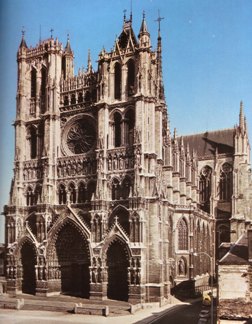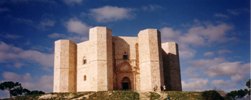|
|
Storia dell'arte - Story of Art
|
|
|
GOTHIC ART
It was born in northern of France, in the first half of the XII century, and appears as union of elements already existing in the Romanic, oriental, and Anglo-roman art. It covers the period from the middle of the XII century to the XV century , and in some cases to XVI century. The most expressive aspect of the gothic art, it is architecture and highest achievement of gothic civilizations is the Cathedral, as a symbol of the power of Church on earth, which has a highly organized structure ; the use of the pointed arch that replaces the heavy Romanic cross vault creating a more elegant vault with pointed arches. The most important examples of gothic architecture in France, are the Cathedrals of Charfres, Reims and Amiens (as in picture). The external decorations are made by rich sculptures and pinnacles; the front side is enriched by two towers and imposing gates, while the inner part is decorated with glass-windows, rose-windows, statues, altar shovels and ex voto. Gothic sculpture manifests statues on the protrusions of the facing, on the kiosks and on top of the pinnacles. In gothic art, painting assumes a secondary role compared with architecture and sculpture; Glass-windows that make the gothic interiors mystical are widely used, rather than the affresco of Romanic tradition which will return in the XIV century. Enamel, like the high quality one from Limages, is beginning to be used for goldsmiths, and the employment of precious metals develops. Civil architecture undergoes important developments with the typical solutions of cities surrounded by walls and fortress-castles.
Later on some Italian architects developed a particular gothic style: horizontal lines prevailed on vertical ones; the walls were enriched with paintings, while rose-windows began to lose importance, the construction of pointed arches was influenced by volume and mass requirements, limiting any excess; A more equilibrated expansion contrasts with the previous idea of verticality. Gothic architecture assumed original characteristics in different regions and cities; from Siena to Florence, to Venice, to southern Italy. In Italian gothic churches prevails the concept of permanent stability, rather than that of the height and of the exasperation of static problems of the vault: for this reason Italian gothic buildings are a direct consequence of Romanic ones, adding French particularities such as pointed arches and decorations.
|
|
|
 It represents the last unitary period of European
medieval art.
It represents the last unitary period of European
medieval art. French gothic architecture arrived in Italy thanks to
the Cistercenses, between the XII and XIII century (abbeys of Fossanova
Casamari and Chiaravalle), later was continued by the Francescani (San
Francesco of Assisi, San Francesco of Bologna), was diffused in southern
Italy by Federico II in Castle del Monte- and later by the Angioini.
French gothic architecture arrived in Italy thanks to
the Cistercenses, between the XII and XIII century (abbeys of Fossanova
Casamari and Chiaravalle), later was continued by the Francescani (San
Francesco of Assisi, San Francesco of Bologna), was diffused in southern
Italy by Federico II in Castle del Monte- and later by the Angioini.